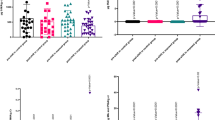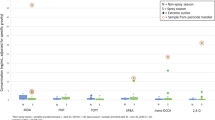Abstract
Tebuconazole (TEB) is a fungicide widely used in vineyards and is a suspected teratogen for humans. The aim of this research was to identify urinary biomarkers and the best sampling time for the biological monitoring of exposure to TEB in agricultural workers. Seven vineyard workers of the Monferrato region, Piedemont, Italy, were investigated for a total of 12 workdays. They treated the vineyards with TEB for 1–2 consecutive days, one of them for 3 days. During each application coveralls, underwears, hand washing liquids and head coverings were used to estimate dermal exposure. For biomonitoring, spot samples of urine from each individual were collected starting from 24 h before the first application, continuing during the application, and again after the application for about 48 h. TEB and its metabolites TEB-OH and TEB-COOH were measured by liquid chromatography/triple quadrupole mass spectrometry. TEB contamination of coveralls and total dermal exposure showed median levels of 6180 and 1020 μg. Urinary TEB-OH was the most abundant metabolite; its excretion rate peaked within 24 h after product application (post 24 h). In this time frame, median levels of TEB-OH and TEB-COOH ranged from 8.0 to 387.8 μg/l and from 5.7 to 102.9 μg/l, respectively, with a ratio between the two metabolites of about 3.5. The total amount of urinary metabolites (U-TEBeq) post 24 h was significantly correlated with both TEB on coveralls and total dermal exposure (Pearson’s r=0.756 and 0.577). The amount of metabolites excreted in urine represented about 17% of total dermal TEB exposure. Our results suggest that TEB-OH and TEB-COOH in post-exposure urine samples are promising candidates for biomonitoring TEB exposure in agricultural workers.
This is a preview of subscription content, access via your institution
Access options
Subscribe to this journal
Receive 6 print issues and online access
$259.00 per year
only $43.17 per issue
Buy this article
- Purchase on Springer Link
- Instant access to full article PDF
Prices may be subject to local taxes which are calculated during checkout



Similar content being viewed by others
References
European Union Statistical Office (EUROSTAT). The Use of Plant Protection Products in the European Union—Data 1992–2003. Office for Official Publications of the European Communities: Luxembourg. 2007.
Istituto nazionale italiano di statistica (ISTAT) Table UF04V—Active substances utilized by farms for area treated in the cultivation of wine grape (area in hectares, quantity in kilograms, mean for hectare in kilograms)—Year 2010. http://agri.istat.it/sag_is_pdwout/jsp/dawinci.jsp?q=plUF00000010000010000&an=2010&ig=1&ct=801&id=3A|45A|74A|76A|77A . (accessed 7 October 2013).
World Health Organization/ Food and Agriculture Organization (WHO/FAO) Joint Meeting on Pesticide Residues on Tebuconazole (107534-96-3), 1994. Available from, IPCS Inchem http://www.inchem.org/documents/jmpr/jmpmono/v94pr10.htm (accessed 11 September 2013).
Environmental Protection Agency (EPA) Federal register http://www.epa.gov/fedrgstr/EPA-PEST/1999/January/Day-08/p319.htm (accessed 11 September 2013).
Health and Safety Database (HSDB) Tebuconazole, 2013. http://toxnet.nlm.nih.gov/cgi-bin/sis/htmlgen?HSDB (accessed 18 February 2014).
Giavini E, Menegola E . Are azole fungicides a teratogenic risk for human conceptus? Toxicol Lett 2010; 198: 106–111.
European Food Safety Autority (EFSA). Conclusion regarding the peer review of the pesticide risk assessment of the active substance tebuconazole. EFSA Scientific Report 2008; 176, pp 1–109. http://www.efsa.europa.eu/it/efsajournal/doc/176r.pdf (accessed 16 September 2013).
Aprea C, Terenzoni B, De Angelis V, Sciarra G, Lunghini L, Borzacchi G et al. Evaluation of skin and respiratory doses and urinary excretion of alkylphosphates in workers exposed to dimethoate during treatment of olive trees. Arch Environ Contam Toxicol 2005; 48: 127–134.
Flack S, Goktepe I, Ball LM, Nylander-French LA . Development and application of quantitative methods for monitoring dermal and inhalation exposure to propiconazole. J Environ Monit 2008; 10: 336–344.
Baldi I, Lebailly P, Jean S, Rougetet L, Dulaurent S, Marquet P . Pesticide contamination of workers in vineyards in France. J Expo Sci Environ Epidemiol 2006; 16: 115–124.
Acropolis Project, Aggregate and Cumulative Risk of Pesticides: an On-Line Integrated Strategy 2013. http://www.acropolis-eu.com/.
Miller JN, Miller JC . Statistics and Chemometrics for Analytical Chemistry 5th edn. Pearson Educational Limited Essex: England. 2005 pp 121.
Kroll MH, Chesler R, Hagengruber C, Blank DW, Kestner J, Rawe M . Automated determination of urinary creatinine without sample dilution: theory and practice. Clin Chem 1986; 32: 446–452.
Knuiman JT, Hautvast JG, van der Heijden L, Geboers J, Joossens JV, Tornqvist H et al. A multi-centre study on within-person variability in the urinary excretion of sodium, potassium, calcium, magnesium and creatinine in 8 European centres. Hum Nutr Clin Nutr 1986; 40: 343–348.
Joossen JV, Geboers J . Monitoring salt intake of the population: methodological considerations. Surveillance of the dietary habits of the population with regards to cardiovascular diseases, EURO-NUT Report 2 1984 pp 61–73 . Wageningen Agricultural University.
American Conference of Governmental Industrial Hygienists (ACGIH). TLVs and BEIs based on the documentation of the threshold limit values for chemical substances and physical agents and biological indices, American Conference of Governmental Industrial Hygienists, Cincinnati, OH, USA 2010.
Colosio C, Fustinoni S, Birindelli S, Bonomi I, De Pascale G, Mammone T et al. Ethylenethiourea in urine as an indicator of exposure to mancozeb in vineyard workers. Toxicol Lett 2002; 134: 133–140.
Acknowledgements
The study was part of the research carried out for the ACROPOLIS project financed by the EU Commission within the Seventh Framework Programme of the European Community for research, technological development and demonstration activities (245163).
Author information
Authors and Affiliations
Corresponding author
Ethics declarations
Competing interests
The authors declare no conflict of interest.
Rights and permissions
About this article
Cite this article
Fustinoni, S., Mercadante, R., Polledri, E. et al. Biological monitoring of exposure to tebuconazole in winegrowers. J Expo Sci Environ Epidemiol 24, 643–649 (2014). https://doi.org/10.1038/jes.2014.14
Received:
Revised:
Accepted:
Published:
Issue Date:
DOI: https://doi.org/10.1038/jes.2014.14
Keywords
This article is cited by
-
Polyvinyl alcohol (PVA) nanofibre matrix encapsulated with tebuconazole fungicide: a smart delivery system against dry root rot disease of black gram
Polymer Bulletin (2023)
-
Pesticide exposure of workers in apple growing in France
International Archives of Occupational and Environmental Health (2022)
-
Concentrations and temporal trends in pesticide biomarkers in urine of Swedish adolescents, 2000–2017
Journal of Exposure Science & Environmental Epidemiology (2020)
-
Wastewater-based epidemiology approach to assess population exposure to pesticides: a review of a pesticide pharmacokinetic dataset
Environmental Science and Pollution Research (2020)
-
Toxicokinetics of a urinary metabolite of tebuconazole following controlled oral and dermal administration in human volunteers
Archives of Toxicology (2019)



